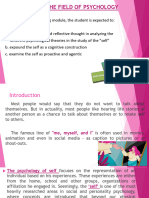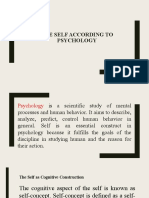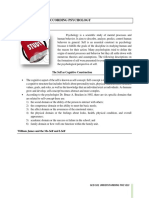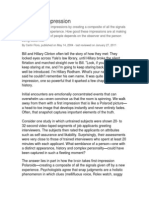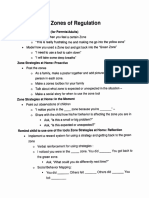Lesson 4 The Self According To Psychology-1
Lesson 4 The Self According To Psychology-1
Uploaded by
Mary Joy CuetoCopyright:
Available Formats
Lesson 4 The Self According To Psychology-1
Lesson 4 The Self According To Psychology-1
Uploaded by
Mary Joy CuetoOriginal Title
Copyright
Available Formats
Share this document
Did you find this document useful?
Is this content inappropriate?
Copyright:
Available Formats
Lesson 4 The Self According To Psychology-1
Lesson 4 The Self According To Psychology-1
Uploaded by
Mary Joy CuetoCopyright:
Available Formats
Lesson 4: The Self-According to Psychology
Psychology is a scientific study of mental processes and human behavior. It aims
to describe, analyze, predict, control human behavior in general. Self is an essential
construct in psychology because it fulfills the goals of the discipline in studying human
and the reason for their action. Many psychologists tried to define the origin of mental
processes and behavior but they all settle down with numerous theories and assumptions.
The following descriptions on the formation of self were presented for you to have a clear picture on the
psychological perspective of self.
The Self as a Cognitive Construct
▪ The cognitive aspect of the self is known as self-concept. Self-concept is defined as self-knowledge,
a cognitive structure that includes beliefs about personality traits, physical characteristics, abilities,
values, goals, and roles, as well as the knowledge that an individual exist as individuals. As humans
grow and develop, self-concept becomes abstract and more complex.
▪ According to the psychologist Dr. Bruce A. Bracken in 1992, there are six specific domains that
are related to self-concept these are:
1) the social domain or the ability of the person to interact with others;
2) the competence domain or the ability to meet the basic needs;
3) the affect domain or the awareness of the emotional states;
4) the physical domain or the feelings about looks, health, physical condition, and overall
appearance;
5) academic domain or the success or failure in the school; and
6) family domain or how well one function within the family unit.
William James and the Me-Self and I-Self
▪ William James is a well-known figure in Psychology who is considered as the founder of
functionalism. He brought prominence to U.S. psychology through the publication of The
THE SELF ACCORDING TO PSYCHOLOGY
Principles of Psychology (1890) that made him more influential than his contemporaries in the
field.
▪ James made a clear distinction between ways of approaching the self – the knower (the pure or the
I – Self) and the known (the objective or the Me – Self). The function of the knower (I-Self)
according to James must be the agent of experience. While the known (Me-Self) have three
different but interrelated aspects of empirical self (known today as selfconcept): the Me viewed as
material, the Me viewed as social, and the Me viewed as spiritual in nature.
▪ The material self is consists of everything an individual call uniquely as their own, such as the
body, family, home or style of dress. On the other hand, social self refers to the recognition an
individual get from other people. Lastly, spiritual self refers to the individual inner or subjective
being.
Real and Ideal Self carl Rogers
▪ Carl Rogers is best known as the founder of clientcentered therapy and considered as one of the
prominent humanistic or existential theorists in personality. His therapy aimed to make the person
achieve balance between their selfconcept (real-self) and ideal self.
▪ The real self includes all those aspects of one's identity that are perceived in awareness. These are
the things that are known to oneself like the attributes that an individual possesses.
▪ The ideal self is defined as one’s view of self as one wishes to be. This contains all the aspirations
or wishes of an individual for themselves.
▪ A wide gap between the ideal self and the self-concept indicates incongruence and an unhealthy
personality.
▪ Psychologically healthy individuals perceive little discrepancy between their self-concept and what
they ideally would like to be.
Multiple versus Unified Self
▪ According to Multiple Selves Theory, there are different aspects of the self exist in an individual.
From here, we can say that self is a whole consist of parts, and these parts manifest themselves
when need arise.
THE SELF ACCORDING TO PSYCHOLOGY
▪ Gregg Henriques proposed the Tripartite Model of Human Consciousness, wherein he described
that self is consist of three related, but also separable domains these are the experimental self,
private self, and public self.
o The experiential self or the theater of consciousness is a domain of self that defined as felt
experience of being. This includes the felt consistency of being across periods of time. It
is tightly associated with the memory. This is a part of self that disappears the moment that
an individual enter deep sleep and comes back when they wake up.
o The private self consciousness system or the narrator/interpreter is a portion of self that
verbally narrates what is happening and tries to make sense of what is going on. The
moment that you read this part, there is somewhat like a “voice” speaking in your head
trying to understand what this concept is all about.
o Lastly, the public self or Persona, the domain of self that an individual shows to the public,
and this interacts on how others see an individual. Henriques’ Tripartite Model attempts to
capture the key domains of consciousness, both within the self and between others.
▪ Unified being is essentially connected to consciousness, awareness, and agency. A well-adjusted
person is able to accept and understood the success and failure that they experienced. They are
those kinds of person who continually adjust, adapt, evolve and survive as an individual with
integrated, unified, multiple selves.
True versus Fals Self Donald Winnicott
▪ Donald Winnicott was a pediatrician in London who studied Psychoanalysis with Melanie Klein,
a renowned personality theorist and one of the pioneers in object relations and development of
personality in childhood.
▪ According to him, false self is an alternative personality used to protect an individual’s true identity
or one’s ability to “hide” the real self. The false self is activated to maintain social relationship as
anticipation of the demands of others. Compliance with the external rules or following societal
norms is a good example of this. false self can be a healthy self if it is perceived as functional for
the person and for the society and being compliant without the feeling of betrayal of true self. On
the other hand, unhealthy false self happens when an individual feels forced compliance in any
situation.
▪ On the contrary, true self has a sense of integrity and connected wholeness that is rooted in early
infancy. The baby
THE SELF ACCORDING TO PSYCHOLOGY
creates experiences of a sense of reality and sense of life worth living. Winnicott claimed that true
self can be achieved by good parenting that is not necessarily a perfect parenting.
The Self as Proactive and Agentic Albert Bandura
▪ Albert Bandura is a psychologist and Professor Emeritus of Social Science in Psychology at
Stanford University. He is known for his theory of social learning by means of modeling. He is
famous for his proposed concept of selfefficacy.
▪ His personality theory, The Social Cognitive Theory asserts that a person is both proactive and
agentic, which means that we have the capacity to exercise control over our life. This theory
emphasized that human beings are proactive, self-regulating, self-reflective, and selforganizing.
▪ Self as proactive means an individual have control in any situation by making things happen.
They act as agent in doing or making themselves as they are. Agency is a defining feature of
modern selfhood. Agents assume some degree of ownership and control over things, both
internally (I control my own thoughts) and externally (I make things happen in the environment).
The ability of an individual to pursue their goals in life is an example of agentic approach to self.
▪ According to Bandura (1989), self-efficacy beliefs determine how people feel, think, motivate
themselves and behave. Such beliefs produce these diverse effects through four major processes.
They include cognitive, motivational, affective and selection processes. A strong sense of efficacy
enhances human accomplishment and personal well-being in many ways.
▪ In contrast Bandura (1989) said that people who doubt their capabilities shy away from difficult
tasks which they view as personal threats. They have low aspirations and weak commitment to
the goals they choose to pursue. When faced with difficult tasks, they dwell on their personal
deficiencies, on the obstacles they will encounter, and all kinds of adverse outcomes rather than
concentrate on how to perform successfully. They fall easy victim to stress and depression.
References:
Arcega, A M., Cullar, D. S., Evangelista, L. D. & Falculan, L. M. (2018). Understanding the Self. Malabon
City: Mutya Publishing House Inc.
Gazzingan, L. B. et al. (2019). Understanding the Self. Muntinlupa City: Panday-Lahi Publishing House,
Inc.
THE SELF ACCORDING TO PSYCHOLOGY
Alata, E.J.P., Caslib, B.N., Serafica, J.P.J., Pawilen, R.A. (2018). Unsertanding the Self. Rex Book Store
Inc., Sta Mesa Heights, Quezon City, Philippines
THE SELF ACCORDING TO PSYCHOLOGY
You might also like
- Psychological Perspective of The SelfDocument5 pagesPsychological Perspective of The SelfCharlton Benedict Bernabe100% (2)
- UTS Module 4-6Document16 pagesUTS Module 4-6mikaela thereseNo ratings yet
- COPE InventoryDocument3 pagesCOPE InventoryAnamaria BrumăNo ratings yet
- Week 4-The Self According PsychologyDocument4 pagesWeek 4-The Self According PsychologyJeffrey ConcepcionNo ratings yet
- Week 4-THE SELF ACCORDING TO PSYCHOLOGYDocument13 pagesWeek 4-THE SELF ACCORDING TO PSYCHOLOGYGlecy RazNo ratings yet
- The Self According PsychologyDocument11 pagesThe Self According PsychologyJAVIER, JEREMY G.No ratings yet
- The Self According To PsychologyDocument18 pagesThe Self According To Psychologyjowsepsanara805No ratings yet
- Uts 4Document6 pagesUts 4Adi SoNo ratings yet
- Lesson 4 the Self According to Psychology 3Document28 pagesLesson 4 the Self According to Psychology 3patriciaelaine.rodriguezNo ratings yet
- UTS Psychological PerspectiveDocument27 pagesUTS Psychological PerspectiveJhon Albert RobledoNo ratings yet
- Self As A Coginitive ConstructDocument26 pagesSelf As A Coginitive ConstructDivine Grace CabardoNo ratings yet
- Lesson 4 The Self From The Perspective of Psychology PLeDF NleeDocument25 pagesLesson 4 The Self From The Perspective of Psychology PLeDF NleeAlec TiongNo ratings yet
- Second Module For UstmidtermDocument19 pagesSecond Module For UstmidtermJohn MarcNo ratings yet
- 4 Psychological Perspective of The Self 1Document4 pages4 Psychological Perspective of The Self 1MicsjadeCastilloNo ratings yet
- Lesson 4 - FROM THE PERSPECTIVE OF PSYCHOLOGYDocument8 pagesLesson 4 - FROM THE PERSPECTIVE OF PSYCHOLOGYTrexia PantilaNo ratings yet
- Module 4 - Psychological Perspective of The SelfDocument7 pagesModule 4 - Psychological Perspective of The SelfJemuel Bucud Lagarto100% (1)
- Week 3 - The-Self-According-to-Anthropology-and-SociologyDocument5 pagesWeek 3 - The-Self-According-to-Anthropology-and-SociologyGlecy RazNo ratings yet
- Psychological Perspective of The SelfDocument21 pagesPsychological Perspective of The Selfere chan100% (1)
- PsychologyDocument35 pagesPsychologyReyilla Mharie EsteronNo ratings yet
- The Self According To PsychologyDocument12 pagesThe Self According To Psychology11No ratings yet
- Chapter 1-1-1Document26 pagesChapter 1-1-1Ghia Mae BiberaNo ratings yet
- Lesson 4 - UTSDocument4 pagesLesson 4 - UTSHitomy CarrascalNo ratings yet
- Uts Midterm P1Document6 pagesUts Midterm P1Kystrel Delos SantosNo ratings yet
- Lesson 4Document23 pagesLesson 4Ayad Lydia MaeNo ratings yet
- 02 (Module) Psychological PerspectivesDocument6 pages02 (Module) Psychological Perspectivesbraunr503No ratings yet
- TOPIC 4 Psychological PerspectiveDocument5 pagesTOPIC 4 Psychological PerspectiveSydney Gladyvelle AlceraNo ratings yet
- Lesson 4 - UTSDocument4 pagesLesson 4 - UTSLiliane BalaneNo ratings yet
- Lesson 4: The Self From The Perspective of PsychologyDocument19 pagesLesson 4: The Self From The Perspective of PsychologyHanna Relator Dolor100% (1)
- Uts1 1Document14 pagesUts1 1Justin NamoroNo ratings yet
- Psychological Perspective Chapter 4Document41 pagesPsychological Perspective Chapter 4Zyra CabualanNo ratings yet
- 3 PsychologyDocument10 pages3 PsychologyWinona BartolomeNo ratings yet
- Lesson 4. PSYCHOLOGYDocument7 pagesLesson 4. PSYCHOLOGYRea Mae ElevazoNo ratings yet
- TOPIC_4_Psychological_PerspectiveDocument5 pagesTOPIC_4_Psychological_PerspectivejbenedictaNo ratings yet
- The Self As A Cognitive ConstructionDocument14 pagesThe Self As A Cognitive ConstructionArian Jean DiamanteNo ratings yet
- PYSCHOLOGICAL PERSPECTIVE OF THE SELF-TRANSESDocument5 pagesPYSCHOLOGICAL PERSPECTIVE OF THE SELF-TRANSESsittisharifa.lakibulNo ratings yet
- Uts M4Document4 pagesUts M4Kirstein Aiko HendersonNo ratings yet
- Self As A Cognitive ConstructDocument10 pagesSelf As A Cognitive Constructjosemarineri386No ratings yet
- Psychology ReflectionDocument9 pagesPsychology ReflectionRinchel ObusanNo ratings yet
- Chapter I: The Self From Various Perspectives D. Psychology: Module OverviewDocument4 pagesChapter I: The Self From Various Perspectives D. Psychology: Module Overviewi'm MNo ratings yet
- Psychology of The SelfDocument3 pagesPsychology of The SelfJayson UrbiNo ratings yet
- Person-Centered Theory Carl RogersDocument7 pagesPerson-Centered Theory Carl RogersGerald BonNo ratings yet
- UTS1Document3 pagesUTS1Princess Lheakyrie CasilaoNo ratings yet
- Module Presentation No. 4 The Self From Various Perspectives - PsychologyDocument31 pagesModule Presentation No. 4 The Self From Various Perspectives - PsychologybryansantoshjhhhNo ratings yet
- Understanding The Self: Chapter 3 - Part 2Document6 pagesUnderstanding The Self: Chapter 3 - Part 2Phee JhayNo ratings yet
- 4 - Week 4 - The Self According To PsychologyDocument4 pages4 - Week 4 - The Self According To PsychologySteve RogersNo ratings yet
- understanding the self report (3)Document27 pagesunderstanding the self report (3)Estrella SalagosteNo ratings yet
- Chapter 4 - UTS (Pychological Perspective)Document23 pagesChapter 4 - UTS (Pychological Perspective)James CancinoNo ratings yet
- Lesson 3Document5 pagesLesson 3johnpaultagsip123No ratings yet
- Understanding The Self AnthropologicalDocument4 pagesUnderstanding The Self AnthropologicalFrankie “KIM” MataNo ratings yet
- Understanding The Self Sociological Anthropological and Psychological PerspectiveDocument6 pagesUnderstanding The Self Sociological Anthropological and Psychological PerspectiveMaria Ainor Jane BaldadoNo ratings yet
- CHAPTER 4 - Psychological SelfDocument9 pagesCHAPTER 4 - Psychological SelfJim Boy BumalinNo ratings yet
- Self As A Cognitive ConstructDocument27 pagesSelf As A Cognitive ConstructYan DuyoNo ratings yet
- The Self From The Perspective of PsychologyDocument16 pagesThe Self From The Perspective of PsychologyTimothy Lontok100% (2)
- Psychological Perspective of SelfDocument5 pagesPsychological Perspective of Selfkrishelleanne.abobo.24No ratings yet
- Psychological Views of SelfDocument38 pagesPsychological Views of SelfGNo ratings yet
- Lesson 3Document4 pagesLesson 3Almie CahiligNo ratings yet
- UTS Module 6Document7 pagesUTS Module 6loader0810No ratings yet
- Theories of PersonalityDocument7 pagesTheories of PersonalityBaba GNo ratings yet
- Lilac Illustrated125Document30 pagesLilac Illustrated125fernandezhenrich88No ratings yet
- Lesson 9 Sexual Self (Understanding Sexual Behavior, STI's and Contraception)Document15 pagesLesson 9 Sexual Self (Understanding Sexual Behavior, STI's and Contraception)Mary Joy CuetoNo ratings yet
- Lesson 7 Physical Self (Importance of Beauty)Document5 pagesLesson 7 Physical Self (Importance of Beauty)Mary Joy CuetoNo ratings yet
- Lesson 5 The Self in The Western Eastern Oriental ThoughtDocument4 pagesLesson 5 The Self in The Western Eastern Oriental ThoughtMary Joy CuetoNo ratings yet
- Lesson 6 Physical Self (Concept of Physical Self)Document5 pagesLesson 6 Physical Self (Concept of Physical Self)Mary Joy CuetoNo ratings yet
- Lesson 15 Learning To Be A Better StudentDocument6 pagesLesson 15 Learning To Be A Better StudentMary Joy CuetoNo ratings yet
- Lesson 12 Political SelfDocument5 pagesLesson 12 Political SelfMary Joy CuetoNo ratings yet
- Lesson 14 Taking Charge of One's HealthDocument4 pagesLesson 14 Taking Charge of One's HealthMary Joy CuetoNo ratings yet
- Lesson 16 - Forestry Protection, Conservation and DevelopmentDocument21 pagesLesson 16 - Forestry Protection, Conservation and DevelopmentMary Joy CuetoNo ratings yet
- Lesson 11 Spiritual SelfDocument14 pagesLesson 11 Spiritual SelfMary Joy CuetoNo ratings yet
- Lesson 12 - Role of Youth in Disaster Preparedness and Management (DPR)Document9 pagesLesson 12 - Role of Youth in Disaster Preparedness and Management (DPR)Mary Joy CuetoNo ratings yet
- Lesson 18 - National Security Concerns: Learning ObjectivesDocument12 pagesLesson 18 - National Security Concerns: Learning ObjectivesMary Joy CuetoNo ratings yet
- Lesson 8 - Philippine Disaster Risk Reduction and Management SystemDocument11 pagesLesson 8 - Philippine Disaster Risk Reduction and Management SystemMary Joy CuetoNo ratings yet
- Lesson 14 - Environmental Education, Protection and ManagementDocument13 pagesLesson 14 - Environmental Education, Protection and ManagementMary Joy CuetoNo ratings yet
- Lesson 4 - Flag Heraldic Code of The Philippines: Learning ObjectivesDocument12 pagesLesson 4 - Flag Heraldic Code of The Philippines: Learning ObjectivesMary Joy CuetoNo ratings yet
- Lesson 2 - Philippine Constitution, Preamble and Bill of RightsDocument12 pagesLesson 2 - Philippine Constitution, Preamble and Bill of RightsMary Joy CuetoNo ratings yet
- Lesson 1 - Historical and Legal Bases of NSTP: Learning ObjectivesDocument3 pagesLesson 1 - Historical and Legal Bases of NSTP: Learning ObjectivesMary Joy Cueto100% (1)
- Essay One Sem 2 Final DraftDocument5 pagesEssay One Sem 2 Final Draftapi-666794714No ratings yet
- GE6 BSE2D Caberoy Nhoricks 1Document13 pagesGE6 BSE2D Caberoy Nhoricks 1Nhoricks Lambatin CaberoyNo ratings yet
- Sample Stress Diary: Circle One: S M T W TH F SDocument2 pagesSample Stress Diary: Circle One: S M T W TH F SAndrey Medrano100% (1)
- All EFT Handouts - Slides For Module 1-6Document28 pagesAll EFT Handouts - Slides For Module 1-6tekia100% (1)
- PessimismDocument31 pagesPessimismمالك احمدNo ratings yet
- Diplomacy: by Cherane ChristopherDocument28 pagesDiplomacy: by Cherane ChristopherCherane ChristopherNo ratings yet
- 2020 - Autism in Higher Education An Investigation of Quality of LifeDocument141 pages2020 - Autism in Higher Education An Investigation of Quality of LifeSilviaNo ratings yet
- Teacher Induction Program Module 3 V1.0Document111 pagesTeacher Induction Program Module 3 V1.0elena calidro73% (22)
- NRNP 6665 Midterm Exam - Version 2Document24 pagesNRNP 6665 Midterm Exam - Version 2slsNo ratings yet
- 1-Prirodno Okruzenje I Mentalno ZdravljeDocument8 pages1-Prirodno Okruzenje I Mentalno ZdravljeUvoBubaNo ratings yet
- GROUP 8 QUIA BRETANA June24 2023finalDocument86 pagesGROUP 8 QUIA BRETANA June24 2023finalRed QuiaNo ratings yet
- The First ImpressionDocument5 pagesThe First ImpressionthewassNo ratings yet
- APA Template 7th Ed. Student PapersDocument6 pagesAPA Template 7th Ed. Student Papersmr.peace636No ratings yet
- LU5-Introduction To EmotionsDocument26 pagesLU5-Introduction To EmotionsEunmi JeonNo ratings yet
- Reading Review 2Document4 pagesReading Review 2Ngô Xuân TrườngNo ratings yet
- Course Design Dressmaking NCIIDocument81 pagesCourse Design Dressmaking NCIIRYDENNo ratings yet
- Emdr Transcript Day 2 Part 1Document46 pagesEmdr Transcript Day 2 Part 1Eva MNo ratings yet
- Chapter 14 &15Document73 pagesChapter 14 &15baconhaterNo ratings yet
- Zones of Regulation ActivitiesDocument9 pagesZones of Regulation Activitiesyvz4ysfj4jNo ratings yet
- Feel Better Blueprint Jennifer McleanDocument18 pagesFeel Better Blueprint Jennifer McleanNobody100% (1)
- Facts, Quotes, and Statistics That YOU Can Use To: Advocate For Music EducationDocument19 pagesFacts, Quotes, and Statistics That YOU Can Use To: Advocate For Music EducationRenggaRyandahZudhaPrawiraNo ratings yet
- The Code of The Noble SpiritDocument22 pagesThe Code of The Noble SpiritYeshwanth Kumar100% (1)
- Leadership in Organizations 7e Ch01Document24 pagesLeadership in Organizations 7e Ch01Claudia A Medina-Castillo100% (5)
- Hope Ziua 4Document2 pagesHope Ziua 4Ancuta Si Ionut CazamirNo ratings yet
- Self CareDocument14 pagesSelf CareStNurfadhilaNo ratings yet
- Affect, Natsume Sōseki, and World Literature: Reiko Abe AuestadDocument18 pagesAffect, Natsume Sōseki, and World Literature: Reiko Abe AuestadGeo OpreaNo ratings yet
- Unit-5 Positive Organizational BehaviorDocument12 pagesUnit-5 Positive Organizational BehaviorBhabuk RijalNo ratings yet
- Understanding-Consumer-Resistance-to-Sustainability InterventionsDocument18 pagesUnderstanding-Consumer-Resistance-to-Sustainability InterventionsWisal BoujeddaineNo ratings yet
- Personality Disorders Cluster ADocument7 pagesPersonality Disorders Cluster AKodhai NarayananNo ratings yet

















